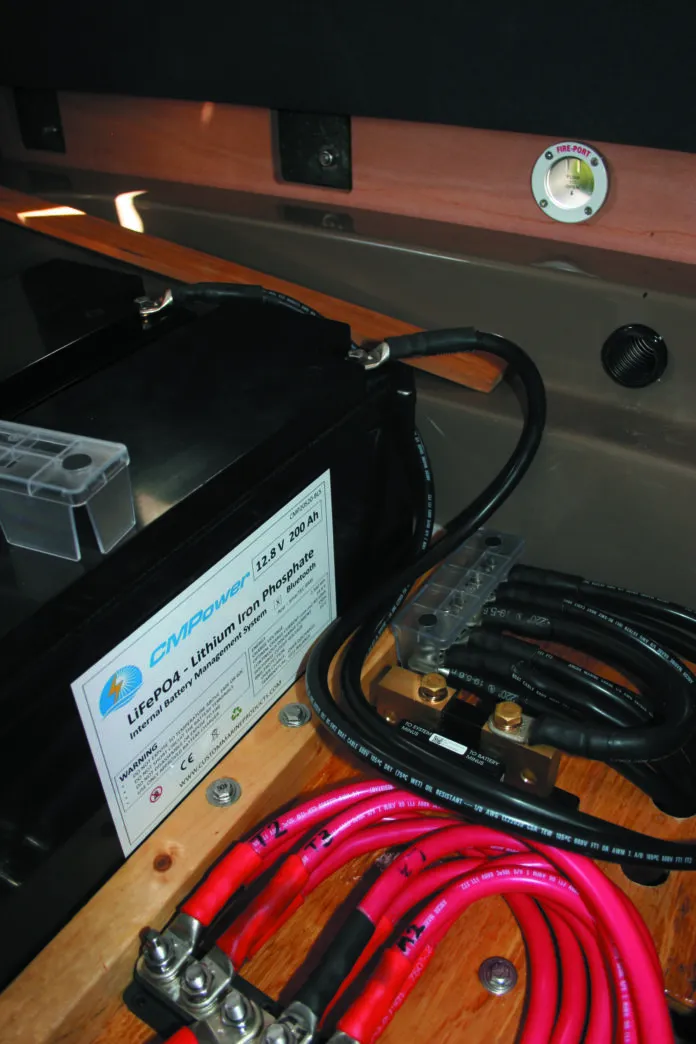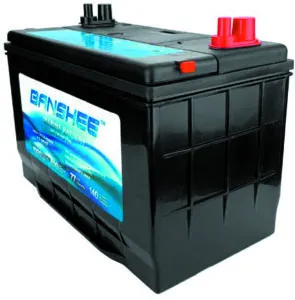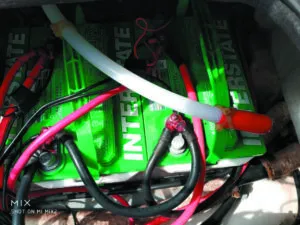
When charging, lead acid batteries generate hydrogen from the electrolysis of water, and some acid gases, the amount of which vary with the battery design, charging rate and state of charge. Hydrogen is explosive at concentrations above 4 percent and acid gases cause corrosion. This is why automobiles with batteries located under a seat or in the trunk are always vented outside through a vent tube. Some batteries designed for applications inside a vehicle are equipped with vent hose fittings, but most are not. Vehicle trunks are very poorly ventilated, and vehicle cabins are essentially unventilated when the vehicle is sitting still.
Of course, cars aren’t usually charging their batteries when they are stationary for long periods, but RVs often charge their batteries when parked, as do boats when they are at anchor. Boats are typically well ventilated when in use, but can be poorly ventilated when sitting still. More concerning is the fact that the greatest charging loads occur after we leave the RV in the driveway or boat at the dock. In addition, battery banks in our boats are typically three to eight times larger—in terms of amp hours— than those in a car.
If a lead-acid battery is located in a locker or under the sole, venting is typically into the cabin. Normal passive cabin venting (dorades or other passive vents) should be sufficient, but in no case should the battery locker be sealed. Intake vents for heating or air conditioning should never draw air from a machinery space or battery locker space. Likewise all intake or return ducts should be sealed off from the battery compartment or engine room to prevent fumes or gases from being spread into living spaces.
Batteries for windlasses and bow thrusters create challenges. Often, they are located in an unventilated space under the V-berth. If these are aftermarket add-ons, vents are often overlooked or blocked by bedclothes. The vent must be directed upward (hydrogen rises and batteries get warm during charging). Sometimes the chain locker is a good termination, but the windlass may be an ignition source. The chain locker should be well ventilated and protected against flooding. Note that the windlass solenoid should not be in the chain locker. It is an ignition source, and even if no battery is present, it is vulnerable to corrosion.
HYDROGEN
How much hydrogen are we talking about? During normal operation the amount is quite small. Valve regulated lead acid (VRLA) batteries (which include gel and AGM types) discharge very little hydrogen if they are matched to the right charger settings and not over charged, but standards established by the American Boat and Yacht Council still requires venting, because accidents happen when something goes wrong.
Flooded lead-acid batteries generate a bit more gases during equalization, when the batteries are intentionally slightly over charged in order to generate a few bubbles and stir the electrolyte. But even then, the amount is small and seldom noticed. (AGM and gel batteries are not equalized, because the mat or gel prevents stratification of the electrolyte.) Hydrogen created during the equalizing process can actually set off CO monitors in poorly ventilated cabins.
A safe battery compartment ventilation setup is based on a realistic failure scenario, which in this case is a neglected, old and failing battery that will not come up to voltage when charged. The charger continues to pumping electrons into it, and instead of going into the charge, the electrons are spent splitting water.
For example, let’s assume 10 amps goes straight to water decomposition. That’s about 864,000 Coulombs or 9 moles of hydrogen gas (96,500 Coulombs/mole). The volume of pure hydrogen is about 220 liters, creating 5,200 liters (183 cubic feet) of 4 percent explosive mixture. That’s enough to fill a 10-ft. by 6-ft. by 3-ft. space, the same volume of a small cabin and certainly more than the volume of a small locker.

This process will continue as long as the battery overcharges, boiling out about 8 ounces of water per day, depending on how much is vapor vs. gas. The numbers will vary, and the above case is an extreme one, but we have also experienced usable but failing batteries that could boil out a few ounces in 24 hours—the rate increases significantly in a battery that has a truly failed. The amount of water electrolyte you have to add to your lead-acid battery can be an early indicator of battery health, but it is not always a good guide.
To sum it up, we must plan for 20 to 200 cubic feet of explosive mixture to be generated by the boat’s batteries. That is not as much as the 310 cubic feet of explosive mixture that a leaking 12-ounce propane cylinder can create. And unlike propane, hydrogen rises to where it is more easily vented. However, the risk is not something to be ignored.
The corollary is that boats with very small chargers (solar or shorepower) or that are not charged when unattended are at low risk. (Think panels 50 watts and below.)
It’s important to note that hydrogen rises fast. It is 14 times lighter than air, half the weight of helium, and 7 times lighter than the hot gases in a candle flame. But once mixed with air and diluted it behaves more like CO2, which does not separate. Don’t bet on rising hydrogen to solve your ventilation problems. Failing batteries can also seriously overheat during charging. Another argument for ample ventilation.
CONCLUSION
Batteries are not benign plastic boxes. In addition to the potential for spills or flooded batteries, and universal requirements for fusing, covering the positive terminal, and strongly securing batteries, consideration for venting during both normal operation and failure scenarios must be considered. This includes all lead acid battery types, including sealed and maintenance-free types. Electrical equipment should not be installed in close proximity unless the location is very well ventilated.
Creating a battery compartment that simplifies routine care is an important step to maintaining healthy batteries. You should have easy access to the terminals, and be able to monitor and maintain electrolyte levels on wet-cells, where used.
FILLER SYSTEMS
The Flow-Rite fill system been around for years and have held up well in past Practical Sailor test boats. I had the Quickfill kit on my PDQ cat because one of the batteries was in a locker with a low ceiling; you could slide the box cover off, but there was no way to see down into the cells or add water with any control.
Refilling the battery became easy. Every month of active cruising, I placed the fill hose in a pint jar of distilled water and pumped the bulb until there was some resistance. If I didn’t have AGMs on my new boat—no water required—I would fit the Quick-Fill kit in a heartbeat.
FLOW-RITE QUICK-FILL
The stock battery caps are replaced by caps that include both a vent and a float that prevents over filling. The caps are chained together with clear tubing, and water is pumped in using a primer bulb, like that used to prime an outboard motor. Adjustable for battery size and installation geometry. Multiple batteries can be chained together. Price is $36 per battery, plus a few dollars for the primer bulb and extension hoses, as needed.
BATTERY FILLING BULBS
Battery filling bulbs go way back. Pouring from a jug, even a specialized one, is tricky in a bilge, and spills are impossible to clean up. I always kept a few pint bottles of water (handier than gallon jugs) and a bulb beside the battery boxes. If a cell was very low I would pour, but otherwise the bulb was fast and accurate. Fill only to the fill ring. There are many brands. Add a short hose, if needed. Price is about $9.
WATER LOSS REDUCTION CAPS
We’ve used these on electric forklifts with limited success. They won’t help with batteries close to failure that are consuming lots of water, but they will reduce routine additions as much as 50 percent. They fit only golf-cart-type batteries with bayonet caps and they require some additional head clearance (they are taller than standard caps). Opinions are mixed regarding whether they must be removed during equalization. Catalytic caps can get quite warm, because the amount of hydrogen increases significantly, and over-filled batteries will spray water into the caps. These are worth it if you live on the hook and cycle the batteries often. For more common use patterns, maybe not.
CATALYTIC CAPS
These contain a mist screen and a catalyst that converts the hydrogen back into water. The primary limitation is that the catalyst, which is susceptible to dirt and acid, only lasts about two years before water consumption begins to increase. It also cannot handle the large volumes released from a failing battery, so venting is still vital. Good for batteries that are chronically ignored—a practice that makes little sense if you’re trying to extend battery life.
HYDROCAP
Hydrocaps have probably been on the market the longest. Recommended to us by the sales team at Trojan batteries about 10 years ago, we’ve used these on one of our test boats, and found them handy. The trouble in some installations is getting enough clearance, since they extend about two inches above the battery. The price is about $17.
DIAMOND SHAMROCK FLUX 100
The Flux 10000 dramatically reduced water loss in forklifts for nearly 2 years. However, they stand 2-3 inches above the battery, so make sure you have enough vertical clearance above the batteries. The Flux 1000 is for batteries under 300 Ah. Price is $15.

WATER MISER.
A chamber filled with plastic beads collects mist and return it to the batteries. The tops also flip open for easy filling. Not as effective as catalytic caps, but long life and east filling are strong points. Height varies (3 sizes) from 1-1.5 inches. Price is about $4-$6 each.

A according to the American Boating and Yacht Council standards for battery installations, a vent system or other means shall be provided to permit the discharge from the boat of hydrogen gas released by the battery.
VENT SYSTEM 10.7.10
— A vent system or other means shall be provided to permit the discharge from the boat of hydrogen gas released by the battery.
BATTERY BOXES 10.7.11
— Battery boxes, whose cover forms a pocket over the battery, shall be vented at the uppermost portion of the cover. Note to 7:10 and 7:11: These requirements also apply to installations of all batteries whether they employ removable vent caps, non-removable caps, are “sealed” or “maintenance free” batteries, or have pressure regulated valve vent systems with immobilized electrolyte (gel batteries).

VRLA BATTERIES AND BOXES
Although battery boxes are required for flooded lead acid batteries, they are not for valve regulated lead acid batteries. A box can reduce cooling and make inspection more difficult. However, they must still be well secured and consideration should be given to the following guidance in ABYC Standard E-10:
– Adequate ventilation should be provided to the bank of batteries to limit the temperature rise during the charging. Sealed valve regulator (SVR) batteries do allow escape of hydrogen gasses during overcharging; therefore, SVR batteries require the same precautions for ventilation as wet (flooded) batteries.

RV RULES
The Recreational Vehicle Industry Association’s Low-Voltage standard similarly requires venting for all battery locations, whether or not batteries are actually installed, and, because of the risk of fuel ignition, prohibits installation of other potentially spark-producing equipment in the same compartment (e.g. inverters, charge controllers, disconnect switches). The RVIA standard for low-voltage system states the following:
— Battery compartments shall be ventilated with openings having a minimum area of 1.7 square inches (1097 mm2) within 2 inches (50.8 mm) of both the top and bottom. Components identified or outfitted for the purpose of housing batteries, such as by the presence of battery cables, shall meet or have provisions for meeting the above requirements.

This post was originally published on 14 March 2022 and has been updated.







































Regarding the Quick-Fill wet cell battery fill system…I can recommend it without hesitation. Two years ago I was planning to replace all six of my 3+ year-old wet-cell batteries with AGM, but couldn’t overcome the $1,524 (+tax) total price delta and so I opted for new wet-cells and a $200 Flow-Rite Quick-Fill system (that Nigel Calder had highly recommended for significantly increasing the longevity of the batteries). As your article points out, the system allows me to remotely refill all battery cells to their recommended level without the time consuming hassle of removing all the boat’s mattresses, cushions and battery compartment access panels that [on my boat] have multiple screws. Moreover, no more removing each battery cap and dealing with ‘turkey baster bulb’ spills. Each month, I simply plug the system’s easily accessed filler hose into a bottle of distilled water and pump. The entire fill process for all the batteries now only takes <5 minutes rather than 60+ previously. One important note, according to FlowRite, the fill jug of distilled water must be located lower than the batteries when using the bulb pump…not sure why, but their tech support was adamant about this.
We had a scary event as we moved the boat to her winter berth north of Boston late October. After a calm motor sail into Boston and securing to the dock, we plugged in the shore line (first time in months as our boat is kept at her summer mooring). We settled in for a last sleep aboard of the season and were awoken to the CO detector in the aft cabin with no combustion sources active in or around the boat. Shortly after that alarm, a second CO detector sounded in the forward cabin. We evacuated the boat and summoned the fire department. They verified with their CO detectors that we had “over 228 ppm of CO” mostly near the bilge and over the 3 lead acid 8D batteries (5 year old) below the floors. After ventilating the boat and disconnecting the shore line, we started to unwind what happened.
Short answer, filling and testing the batteries are part of our winter prep checklist, but this event cause us to perform this right away! One single cell in one of the 8Ds was reading “low” by hydrometer, with the rest reading as “good”. Immediately an overcharge condition was suspected as the battery charger was trying to satisfy the current demand of the low battery at the expense of overcharging the other batteries. I was not able to verify the CO detectors used by the fire department were hydrogen compensated, but I suspect not since they were reading “CO” just like the ones installed in the boat.
Moral of the story- CO alarms from uncompensated detectors may be hydrogen outgassing, and test your battery frequently!
Everything is neat and tidy in the photo of the battery compartment at the beginning of this story except that the cable connections on the positive buss are not covered. Sure hate to drop a tool on there!